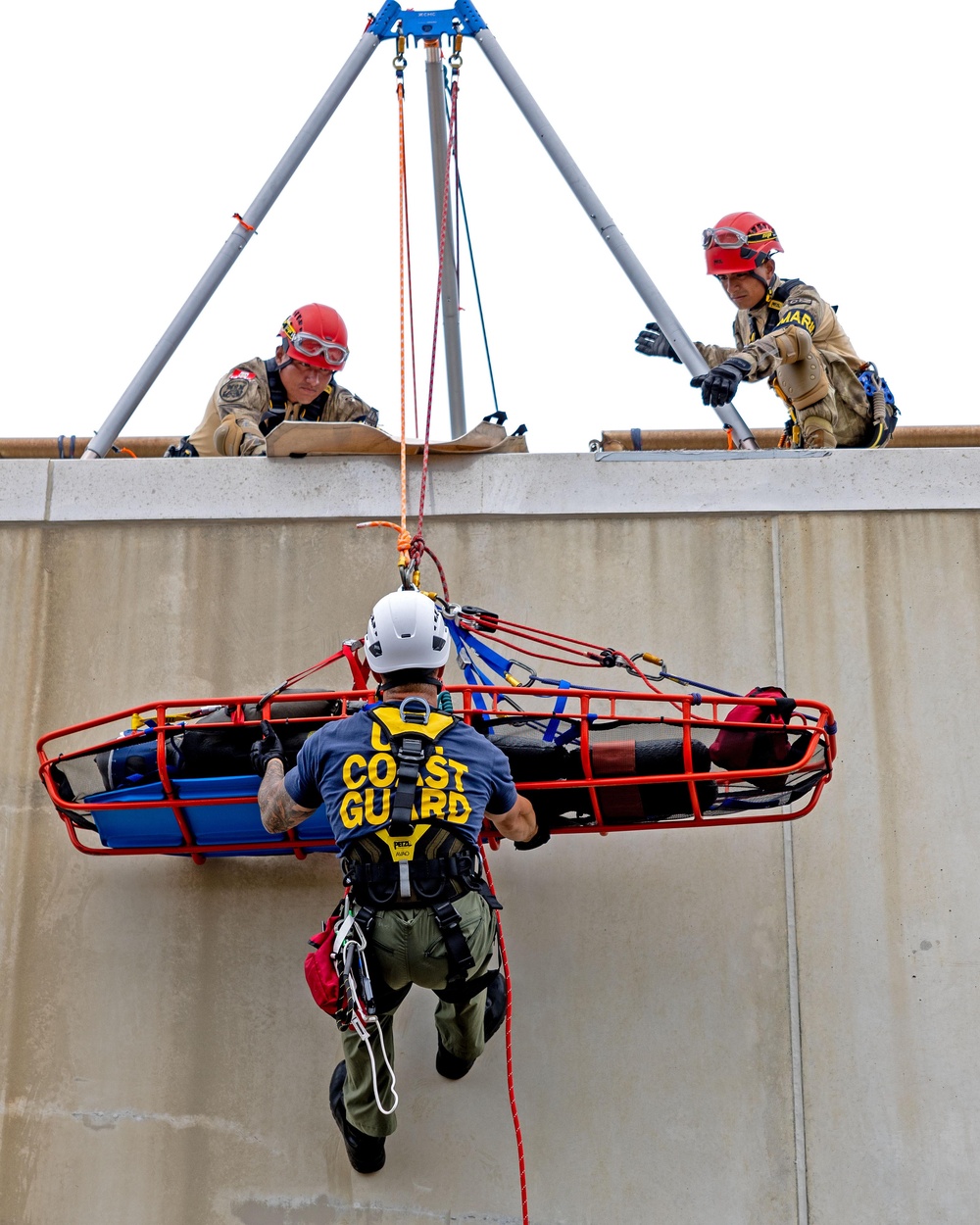DVIDS – News – U.S. Coast Guard, Peruvian, Mexican partners collaborate on first urban search and rescue operations in Exercise RIMPAC 2024
July 13 marked the completion of the first urban search and rescue exercises in RIMPAC history, illustrating the growing value of the world’s largest maritime exercise and the increased range and usefulness of the U.S. Coast Guard.
Hurricanes, typhoons, flooding and tsunamis can inundate coastal communities and trap residents in their buildings, often driving them into their attics or roof spaces to escape rising waters. Members from the U.S. Coast Guard Pacific Strike Team, the Peruvian Naval Infantry and the Mexican Navy collaborated for three days of combined training, simulated search and rescue coordination and survivor extraction and triage as part of the humanitarian assistance and disaster response component of RIMPAC.
The exercises paired teams from the three countries in a range of disaster scenarios. The Mexican and Peruvian teams brought expertise at rescuing survivors from damaged structures, while the U.S. team contributed tactics for water-based rescues and the detection and identification of hazardous materials.
“Natural disasters present serious rescue challenges in urban areas, so we were all grateful for the chance to share our experiences and tactics that have saved hundreds of lives during recent storms and flooding events around the United States,” said Chief Warrant Officer Ian Thompson, the Urban Search and Rescue coordinator for the USCG Pacific Strike Team. “All three teams leave this collaboration with a greater capability to collaborate and to save lives after disasters in our home countries and abroad.”
The teams drove inflatable boats into a simulated flooded community and practiced cutting through a roof. In a separate exercise area on Marine Corps Base Hawaii, they practiced vertical extraction, or moving injured medical patients up and out of buildings using vertical rescue systems with tripods, ropes and pulleys and entering confined spaces with atmospheric contamination to rescue victims.
Additionally, the USCG utilized the Federal Emergency Management Agency’s Geographic Information Systems “SARCOP.” This smartphone app connects rescue coordinators and search teams via a common operating picture. By the end of the exercise, the three countries could coordinate via SARCOP, which will streamline coordination during future responses.
“Participating in these exercises has been invaluable for our teams,” said Lt. j.g. Gonzalo Hernandez of the Peruvian Naval Infantry. “We have not only improved our technical skills but also strengthened our ability to work alongside our international partners. The use of the SARCOP app has significantly enhanced our coordination capabilities, which will enhance our collective response to natural disasters.”
“Working with the U.S. Coast Guard and Peruvian Navy is really good for us, we can learn a lot of their techniques and share how we work in Mexico,” said Seaman Lizeth Magaña, Mexican Navy USAR team member. “We are so grateful for this partnership opportunity in RIMPAC.”
The Novato, Calif.-based U.S. Coast Guard Pacific Strike Team provides an expert deployable force for search and rescue operations, pollution and hazardous material spills, and recovering from weapons of mass destruction.
Historically, the Strike Team has conducted search and rescue missions following major disasters such as Hurricane Harvey, Katrina, and most recently Hurricane Ian. The Coast Guard has enhanced its disaster response capabilities in the past decade by incorporating flood response abilities into Catastrophic Incident Search and Rescue. This modernization effort involved strategically placing Mobile Response Kits across the US and formalizing training programs for all CISAR teams. This training is jointly led by the USCG and US-based USAR teams.
“We are honored to have participated in such a comprehensive exercise,” said Hernandez. “The shared experiences and knowledge gained here are invaluable, and we look forward to applying these lessons to improve our disaster response capabilities.”
To support people affected by different natural or man-made disasters, the principal mission of the Mexican Navy USAR Team is to carry out operations of search, location, access and stabilization of rescued people. They also perform body recovery.
Twenty-nine nations, 40 surface ships, three submarines, 14 national land forces, more than 150 aircraft and 25,000 personnel are participating in RIMPAC in and around the Hawaiian Islands, June 27 to Aug. 1. The world’s largest international maritime exercise, RIMPAC provides a unique training opportunity while fostering and sustaining cooperative relationships among participants critical to ensuring the safety of sea lanes and security on the world’s oceans. RIMPAC 2024 is the 29th exercise in the series that began in 1971.
| Date Taken: | 07.19.2024 |
| Date Posted: | 07.19.2024 21:56 |
| Story ID: | 476672 |
| Location: | PEARL HARBOR, HAWAII, US |
| Web Views: | 32 |
| Downloads: | 0 |
PUBLIC DOMAIN
This work, U.S. Coast Guard, Peruvian, Mexican partners collaborate on first urban search and rescue operations in Exercise RIMPAC 2024, by LCDR David Connor, identified by DVIDS, must comply with the restrictions shown on https://www.dvidshub.net/about/copyright.


 Private Internet Access gives you unparalleled access to thousands
of next-gen servers in over 83 countries and each US state. Your
VPN experience will always be fast, smooth, and reliable.
Private Internet Access gives you unparalleled access to thousands
of next-gen servers in over 83 countries and each US state. Your
VPN experience will always be fast, smooth, and reliable.![DVIDS – Images – USCG, CBP, HSI seize vessel with $28M in illicit narcotics off Miami Beach [Image 2 of 4] DVIDS – Images – USCG, CBP, HSI seize vessel with $28M in illicit narcotics off Miami Beach [Image 2 of 4]](https://101veterans.com/wp-content/uploads/2025/12/1765139619_1000w_q95.jpg)
![DVIDS – Images – USCG, CBP, HSI seize vessel with $28M in illicit narcotics off Miami Beach [Image 3 of 4] DVIDS – Images – USCG, CBP, HSI seize vessel with $28M in illicit narcotics off Miami Beach [Image 3 of 4]](https://101veterans.com/wp-content/uploads/2025/12/1765074729_1000w_q95.jpg)
